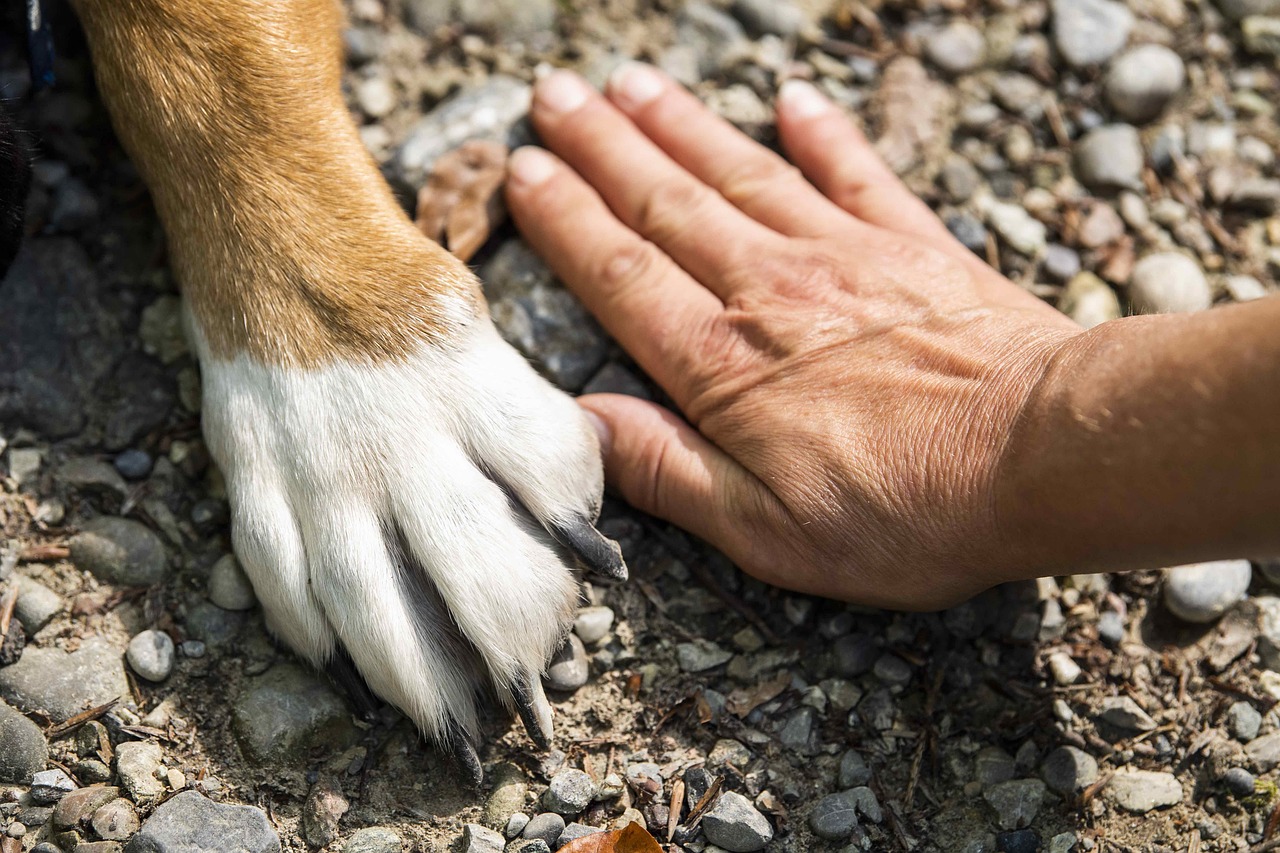What to Do If Your Pet Shows Signs of Distress
As pet owners, we all want to ensure our furry friends are happy and healthy. However, sometimes our pets can experience distress, which can manifest in various ways. Recognizing these signs early is crucial for their well-being. Imagine your pet as a little bundle of emotions, unable to voice their discomfort, relying solely on their behavior to communicate with you. This article dives deep into understanding those signs of distress, what might be causing them, and most importantly, what you can do to help your beloved companion.
First and foremost, it's essential to understand that pets, just like humans, can experience a range of emotions, including anxiety, fear, and sadness. They might not be able to tell you when something is wrong, but their actions often speak volumes. For instance, a sudden change in behavior, such as hiding away, excessive barking, or even loss of appetite, can be red flags indicating that something isn't quite right. Just as you would notice a friend acting differently, your keen observation can make a world of difference in your pet’s life.
So, what should you do if you suspect your pet is in distress? The first step is to remain calm and assess the situation. Take a moment to observe your pet’s behavior closely. Are they pacing? Have they stopped playing? Are they unusually clingy or withdrawn? These behaviors can provide insight into their emotional state. Sometimes, it might just be a case of the 'blues'—perhaps they miss their favorite toy or are adjusting to a new environment. However, if these signs persist, it’s crucial to take action.
Next, consider the environment your pet is in. Pets are incredibly sensitive to changes around them. A new home, a recent loss in the family, or even a change in routine can trigger distress. If you’ve recently moved or introduced a new family member, your pet may need some extra love and attention to help them adjust. Think of it like adjusting to a new job; it takes time to settle in and feel comfortable. Providing a consistent routine can help ease your pet’s anxiety and make them feel secure.
Moreover, addressing your pet's distress goes beyond just observation. It involves creating a supportive environment where they can feel safe and relaxed. This includes providing a cozy space where they can retreat when feeling overwhelmed. Consider setting up a designated area with their favorite blanket or toys—this can serve as their personal sanctuary. Remember, just as we all need a safe haven to recharge, so do our pets.
In addition to creating a safe space, employing calming techniques can significantly help soothe your distressed pet. Techniques such as gentle petting, playing soft music, or using pheromone diffusers can create a calming atmosphere. Think of it as creating a spa day for your pet; a little pampering can go a long way in alleviating stress. If your pet enjoys cuddling, take the time to snuggle with them—it can be incredibly comforting for both of you!
Finally, if you notice that your pet’s distress doesn’t improve or worsens, it may be time to seek professional help. Consulting a veterinarian or an animal behaviorist can provide you with the tools needed to address your pet’s specific issues. They can help identify underlying health problems or behavioral issues that may be contributing to your pet’s distress. Just as you would consult a doctor when feeling unwell, your pet deserves the same level of care and attention.
In conclusion, recognizing and addressing signs of distress in your pet is a vital part of responsible pet ownership. By paying attention to their behavior, creating a supportive environment, and seeking professional help when necessary, you can ensure that your furry friend leads a happy and healthy life. Remember, your pet depends on you to be their voice; so let’s make sure we’re listening!
- What are the common signs of distress in pets? Look for changes in behavior such as hiding, excessive barking, loss of appetite, or unusual aggression.
- How can I help my pet feel more secure? Create a safe space, maintain a consistent routine, and provide plenty of love and attention.
- When should I seek professional help for my pet? If your pet's distress persists or worsens, it’s essential to consult a veterinarian or an animal behaviorist.

Recognizing Signs of Distress
Understanding the common indicators that your pet may be in distress is crucial for timely intervention. Just like humans, our furry friends can experience a wide range of emotions, and it’s essential to be attuned to their needs. Pets can’t speak up when something is wrong, so observing their behavior closely can make all the difference in their well-being. Have you ever noticed your pet acting differently? Maybe they’re hiding more than usual or have lost interest in their favorite toys. These subtle changes can be signs that something is amiss.
Some of the most common signs of distress in pets include:
- Changes in Appetite: A sudden increase or decrease in food intake can indicate stress or discomfort.
- Excessive Barking or Meowing: If your pet is vocalizing more than usual, it might be their way of expressing anxiety.
- Withdrawal or Hiding: Pets that retreat to their favorite hiding spots may be trying to cope with stress.
- Destructive Behavior: Chewing on furniture or scratching at doors can be a sign of frustration or anxiety.
- Changes in Grooming Habits: Over-grooming or neglecting grooming can signal emotional distress.
It’s important to remember that each pet is unique, and their signs of distress may vary. Some pets might exhibit physical symptoms, such as trembling or pacing, while others may show behavioral changes, like aggression or clinginess. Keeping a close eye on your pet's routine and habits can help you spot these signs early. Just think of it as tuning into a radio station; if you don’t adjust the dial, you might miss out on important signals. By being proactive and observant, you can help ensure that your pet remains happy and healthy.
Ultimately, recognizing these signs is the first step toward providing the support your pet needs. If you notice any of these behaviors persisting over time or escalating in severity, it’s essential to take action. Whether it’s a simple adjustment in their environment or a trip to the vet, addressing their distress can lead to a happier, healthier life for your beloved companion.

Common Causes of Distress
Understanding the in pets is essential for any pet owner who wants to ensure the happiness and well-being of their furry friends. Just like us, pets can experience a range of emotions, and various factors can trigger feelings of anxiety, fear, or discomfort. By being aware of these triggers, you can take proactive steps to help your pet feel safe and secure.
One of the most significant contributors to pet distress is environmental changes. Pets are creatures of habit, and sudden shifts in their surroundings can lead to confusion and anxiety. For example, moving to a new home, the arrival of a new family member (whether human or animal), or even changes in daily routines can unsettle your pet. It's important to recognize that these changes, while often exciting for us, can be quite overwhelming for our pets.
Another common cause of distress is health-related issues. Just like humans, pets can suffer from a variety of medical conditions that can affect their mood and behavior. From chronic pain to infections, the physical discomfort can lead to signs of distress. For instance, a pet that is usually playful may suddenly become withdrawn or irritable, which could indicate that something is wrong. Understanding the link between health and emotional well-being is crucial for timely intervention.
When discussing health-related issues, it’s vital to consider the following:
- Chronic Pain: Pets suffering from chronic pain may exhibit changes in behavior, such as reluctance to move, excessive grooming of a painful area, or sudden aggression. Recognizing these signs early can lead to effective pain management and improved quality of life.
- Infections and Illnesses: Signs of distress can also stem from infections or illnesses. Pets may show symptoms such as lethargy, loss of appetite, or unusual vocalizations. If you notice these signs, it’s essential to consult a veterinarian for a proper diagnosis and treatment plan.
Lastly, emotional triggers can also play a significant role in your pet's distress. Pets can be sensitive to stressful situations, such as loud noises (think thunderstorms or fireworks), changes in family dynamics, or even the emotional state of their owners. If you’re feeling anxious or stressed, your pet may pick up on those vibes and mirror those feelings. This emotional connection is why it’s important to maintain a calm and reassuring atmosphere for your pets.
In summary, being aware of the common causes of distress in pets can help you take the necessary steps to address these issues effectively. By recognizing the signs and understanding the triggers, you can create a supportive environment that promotes your pet's emotional well-being.
Q: What are the first signs I should look for if I suspect my pet is distressed?
A: Common signs include changes in behavior such as increased aggression, withdrawal, excessive barking or meowing, and changes in eating or sleeping patterns.
Q: How can I help my pet adjust to environmental changes?
A: Gradually introduce new environments, maintain a consistent routine, and provide plenty of positive reinforcement and comfort during the transition.
Q: When should I take my pet to the vet for signs of distress?
A: If your pet's behavior changes significantly, especially if accompanied by physical symptoms like vomiting or lethargy, it's best to consult a veterinarian.
Health-Related Issues
When it comes to our furry companions, their health is paramount to their overall happiness and emotional well-being. Just like humans, pets can experience a range of health-related issues that may manifest as signs of distress. It’s essential to be vigilant and recognize these signs early on to ensure your pet receives the care they need. After all, a happy pet often means a happy owner!
One of the most common health problems that can lead to distress is chronic pain. Imagine living with constant discomfort; it can change your personality and behavior, right? Pets are no different. They may become withdrawn, irritable, or exhibit changes in their usual routines. For instance, a dog that used to love playing fetch might suddenly lose interest. In such cases, it’s crucial to consult with a veterinarian, who can help identify the source of the pain and recommend appropriate pain management strategies.
In addition to chronic pain, infections and illnesses can also trigger distressing behaviors in pets. These conditions can range from mild to severe, and spotting the signs early can make all the difference. Common indicators that your pet might be unwell include:
- Loss of appetite
- Excessive grooming or scratching
- Changes in bathroom habits
- Unusual vocalizations or lethargy
If you notice any of these symptoms, it’s essential to take action. A visit to the vet can help diagnose the issue, and timely treatment can often lead to a swift recovery. Remember, just like us, pets can’t always tell us what’s wrong, so being observant is key!
Moreover, regular veterinary check-ups can help catch potential health issues before they escalate into something more serious. It’s always better to be proactive about your pet’s health rather than reactive. Just like a car needs regular maintenance to run smoothly, our pets require consistent check-ups to ensure they stay in tip-top shape.
In summary, being aware of health-related issues in pets is critical for their emotional and physical well-being. Whether it’s chronic pain or an underlying illness, recognizing the signs and seeking veterinary care can lead to happier, healthier pets. Don’t underestimate the power of observation—your furry friend relies on you to be their voice when they can’t speak for themselves.
Q: How can I tell if my pet is in pain?
A: Look for signs such as changes in behavior, reluctance to move, excessive whining or barking, and changes in appetite or grooming habits.
Q: What should I do if I suspect my pet is sick?
A: Schedule an appointment with your veterinarian as soon as possible for a thorough examination and diagnosis.
Q: How often should I take my pet for a check-up?
A: It’s generally recommended to take your pet for a check-up at least once a year, but older pets or those with health issues may need more frequent visits.
Q: Can I manage my pet's pain at home?
A: While there are some home remedies you can try, always consult your veterinarian before administering any treatment to ensure it’s safe and effective for your pet.
Chronic Pain
Chronic pain in pets is often an invisible struggle, much like a shadow lurking in the background, affecting their quality of life without obvious signs. It can stem from various conditions such as arthritis, hip dysplasia, or past injuries. Recognizing the signs of chronic pain is crucial for pet owners, as our furry friends can't vocalize their discomfort like we do. Instead, they might express their pain through subtle changes in behavior that can easily go unnoticed. For instance, a once-playful dog may suddenly lose interest in fetching a ball, or a cat that used to leap gracefully onto counters may now hesitate or avoid jumping altogether.
Observing your pet closely can help you identify these changes. Here are some common indicators that your pet may be experiencing chronic pain:
- Changes in Activity Level: If your pet seems less active or reluctant to engage in their usual activities, it could be a sign of discomfort.
- Altered Grooming Habits: Pets in pain may groom themselves less often or, conversely, excessively groom a specific area to soothe their discomfort.
- Behavioral Changes: Increased irritability, withdrawal from family interactions, or changes in sleeping patterns can also signal chronic pain.
It's essential to understand that chronic pain can significantly affect not only your pet's physical health but also their emotional well-being. Just like humans, pets can experience anxiety and depression as a result of living with persistent pain. They may become more withdrawn or irritable, making it challenging for them to enjoy life as they once did. Therefore, if you suspect your pet is suffering from chronic pain, seeking veterinary care is paramount. A veterinarian can perform a thorough examination, recommend diagnostic tests, and develop a tailored pain management plan that may include medications, physical therapy, or alternative treatments like acupuncture.
Moreover, managing chronic pain is not just about alleviating discomfort; it's about enhancing your pet's overall quality of life. Just imagine how much better your furry friend would feel if they could romp around without pain! By addressing chronic pain proactively, you can help them regain their zest for life, allowing them to enjoy those cherished moments spent with you, whether it's a brisk walk in the park or a cozy snuggle on the couch.
In summary, recognizing the signs of chronic pain in your pet is the first step in ensuring they receive the care they need. Don't hesitate to consult with your veterinarian if you notice any of the aforementioned signs. After all, your pet relies on you to be their advocate, and understanding their pain is a crucial part of that responsibility.
Infections and Illnesses
When it comes to our furry companions, infections and illnesses can be sneaky culprits that lead to distress. Often, pets can't vocalize their discomfort, leaving us to decipher their behaviors. It's essential to be vigilant and observant. For instance, if your pet suddenly becomes lethargic, refuses to eat, or shows signs of unusual aggression, it might be time to dig deeper into their health. Understanding the signs of infection or illness can make all the difference in ensuring your pet receives the care they need.
Common infections in pets include bacterial infections, viral infections, and parasitic infestations. Each type can manifest through various symptoms, and recognizing these can help you act swiftly. Here are some signs to watch for:
- Changes in Appetite: A sudden increase or decrease in food intake can signal underlying health issues.
- Vomiting or Diarrhea: These symptoms can indicate gastrointestinal infections or parasites.
- Coughing or Sneezing: Respiratory infections may present with these symptoms, often accompanied by nasal discharge.
- Fever: If your pet feels unusually warm to the touch, it could be a sign of infection.
It's also vital to consider the context of these symptoms. For example, if your pet has recently been in contact with other animals or has been exposed to new environments, the likelihood of picking up an infection increases. Regular veterinary check-ups can help catch potential health issues before they escalate. Your vet will likely conduct a thorough examination and may recommend tests such as blood work or imaging to diagnose the problem accurately.
In some cases, illnesses like canine parvovirus or feline leukemia can be life-threatening and require immediate medical attention. Understanding the importance of timely intervention cannot be overstated. If you suspect your pet is unwell, don’t hesitate to contact your veterinarian. They can provide the necessary guidance and treatment options tailored to your pet's specific needs.
In summary, being proactive about your pet's health can significantly enhance their quality of life. By recognizing the signs of infections and illnesses early and seeking veterinary care, you can help your beloved animal get back to their happy, playful self in no time.
Q: What should I do if my pet shows signs of illness?
A: If your pet displays symptoms such as lethargy, vomiting, or changes in appetite, it's crucial to consult your veterinarian as soon as possible for a proper diagnosis and treatment.
Q: How can I prevent infections in my pet?
A: Regular vaccinations, maintaining good hygiene, and ensuring your pet is on a proper parasite prevention program can help minimize the risk of infections.
Q: Are there any home remedies for minor pet illnesses?
A: While some mild symptoms can be managed at home, it's always best to consult with a veterinarian before administering any treatment to ensure your pet's safety.
Environmental Changes
Pets are incredibly perceptive creatures, and their emotional well-being is closely tied to their environment. When there are significant shifts in their surroundings, such as moving to a new home, the arrival of a new family member, or even changes in daily routines, your furry friends can experience heightened levels of stress and anxiety. Just like humans, pets thrive on stability and familiarity, and any disruption can lead to behavioral changes that may signal distress.
Consider how you feel when you move to a new city or change jobs; the uncertainty and adjustment period can be overwhelming. Similarly, pets may react to environmental changes in ways that can be puzzling for their owners. For instance, a dog might start barking excessively, while a cat might hide in a corner, avoiding interaction. These behaviors are their way of expressing discomfort and anxiety.
Here are some common environmental changes that can affect your pet:
- Moving to a New Home: The unfamiliar sights, sounds, and smells can be disorienting for pets.
- New Family Members: Whether it’s a baby, another pet, or even a new partner, introductions can be stressful.
- Changes in Routine: Pets are creatures of habit, and any deviation from their daily schedule can lead to confusion.
To help your pet adjust to these changes, it’s essential to maintain a sense of normalcy as much as possible. This could mean sticking to their feeding schedule, keeping their favorite toys accessible, and providing plenty of reassurance through gentle petting and soothing words. Over time, with your support, your pet can learn to feel safe and secure in their new environment.
Additionally, creating a designated safe space for your pet can significantly ease their transition. This space should be familiar and comforting, equipped with their bed, toys, and anything else that makes them feel at home. It’s their little sanctuary where they can retreat and relax when the world feels overwhelming.
Ultimately, being aware of how environmental changes can impact your pet's emotional state is crucial. By recognizing the signs of distress and taking proactive steps to support them, you can help your furry companions navigate these changes with greater ease and comfort.
- What are some signs my pet is stressed due to environmental changes?
Look for signs such as excessive barking, hiding, changes in appetite, or destructive behavior. - How long does it take for a pet to adjust to a new environment?
Every pet is different, but it can take anywhere from a few days to several weeks for them to adapt. - Should I consult a vet if my pet doesn’t adjust?
If your pet shows prolonged signs of distress, it’s wise to consult a veterinarian or animal behaviorist for guidance.

Immediate Actions to Take
When your furry friend shows signs of distress, it can be a heart-wrenching experience. You might feel helpless, but knowing the right steps to take can make a world of difference in alleviating their discomfort. The first thing to remember is that your pet relies on you for comfort and reassurance. Immediate actions can help soothe their anxiety and create a sense of security. Here are some effective strategies to consider:
Creating a safe space for your pet is paramount. Think of it as building a cozy sanctuary where they can retreat when the world feels overwhelming. This space should be quiet, away from the hustle and bustle of daily life, and filled with their favorite toys and bedding. You might want to include a familiar blanket or an item that carries your scent, as it can provide a sense of comfort. If your pet is particularly anxious, consider using a crate or a designated room where they can feel secure.
Using calming techniques can also play a significant role in alleviating your pet's distress. Gentle petting can be incredibly soothing; just like how a warm hug can help us feel better, your touch can reassure your pet. Additionally, calming music has been shown to have a positive effect on pets. You can find playlists specifically designed for animals, which can help create a peaceful atmosphere. Moreover, consider using pheromone diffusers that release calming scents, mimicking the natural pheromones that pets produce to feel safe.
Another effective method is to engage your pet in light activities that can distract them from their distress. A leisurely walk, a gentle game of fetch, or even some interactive playtime can redirect their focus and help lift their spirits. Just like humans, pets can benefit from a little distraction when they're feeling low. Make sure to monitor their energy levels and adjust the activity to suit their comfort, ensuring it’s a positive experience.
If your pet is particularly restless or anxious, you might also want to explore the option of using natural calming supplements. These can be found in various forms, such as treats, sprays, or drops. However, it's essential to consult with your veterinarian before introducing any new products to ensure they are safe and appropriate for your pet's specific needs.
In conclusion, addressing your pet's distress requires a combination of creating a safe environment, using calming techniques, and engaging them in positive activities. By taking these immediate actions, you can help your beloved companion find comfort and reassurance during challenging times. Remember, your presence and support are invaluable in helping them navigate their feelings.
- What are some signs that my pet is in distress?
Look for changes in behavior such as excessive barking, hiding, aggression, or changes in eating habits. These can be indicators that something is bothering them. - How can I tell if my pet is in pain?
Signs of pain can include limping, reluctance to move, whining, or changes in grooming habits. If you suspect pain, consult your veterinarian for an assessment. - Are there any specific calming products you recommend?
Natural calming supplements, pheromone diffusers, and calming music playlists can be effective. Always consult your vet for recommendations tailored to your pet. - When should I seek professional help for my distressed pet?
If your pet's distress persists for more than a few days or worsens, it's crucial to consult a veterinarian or an animal behaviorist for professional guidance.
Creating a Safe Space
When your furry friend shows signs of distress, one of the most effective ways to help them is by creating a safe space. Think of this space as a cozy little sanctuary where your pet can retreat when the world feels overwhelming. Just like we all need a comforting corner to unwind after a long day, your pet deserves a similar haven. So, how do you go about crafting this special spot? Let’s dive in!
First, consider the location. Ideally, it should be a quiet area of your home, away from the hustle and bustle of everyday life. A corner in a bedroom or a cozy nook in the living room can work perfectly. Make sure it’s a place where your pet feels secure, away from loud noises, sudden movements, or any other potential stressors. You want them to feel like they can truly relax without interruptions.
Next, think about the comfort items you can include. Just like a favorite blanket or a beloved stuffed animal can bring us comfort, your pet will benefit from familiar items that smell like them or you. Here are some suggestions for what to include in their safe space:
- Soft bedding: A plush bed or a pile of blankets can provide a warm and inviting spot for your pet to curl up.
- Toys: Include some of their favorite toys to keep them entertained and distracted from whatever is causing their distress.
- Familiar scents: If possible, add an item of your clothing or a blanket that carries your scent to help them feel more secure.
Additionally, consider the lighting in this space. Soft, dim lighting can create a calm atmosphere. If your pet enjoys being outside, you might even think about setting up a safe outdoor area where they can enjoy fresh air without feeling exposed or anxious. Just ensure it’s secure and free from potential dangers.
Lastly, it’s important to respect your pet’s need for privacy. When they retreat to their safe space, allow them the time and space they need. Avoid forcing interaction or trying to coax them out. Instead, let them come to you when they’re ready. This respect for their boundaries can help reinforce the idea that their safe space is indeed a sanctuary.
In summary, creating a safe space for your pet involves thoughtful consideration of location, comfort items, lighting, and privacy. By taking these steps, you can provide your pet with a comforting refuge that helps alleviate their distress and promotes a sense of security. Remember, the goal is to help them feel relaxed and at ease, allowing their natural instincts to take over as they find comfort in their surroundings.
Using Calming Techniques
When your furry friend is feeling stressed, it’s essential to have a toolkit of calming techniques ready to help them unwind. Just like humans, pets can benefit from soothing environments and gentle interactions that promote relaxation. Imagine your pet as a tightly wound spring; with the right techniques, you can help them slowly decompress and find their inner peace. Below are some effective methods to consider:
First and foremost, gentle petting can work wonders. The simple act of stroking your pet's fur can release oxytocin, a hormone that reduces stress and promotes bonding. Try to find a quiet spot where your pet feels safe and comfortable, and take your time. Use slow, rhythmic strokes, and watch their body language. If they lean into your touch or close their eyes, you know you’re on the right track!
Another technique worth exploring is calming music. Just as some people find solace in their favorite tunes, pets can also respond positively to soothing sounds. You can find playlists specifically designed for pets that feature soft classical music or nature sounds. Play this in the background while you’re spending time with your pet. It can create a serene atmosphere that helps them relax and feel at ease.
In addition to music, consider using pheromone diffusers. These products release synthetic pheromones that mimic the calming scents produced by mother animals. They can be particularly effective in reducing anxiety during stressful situations, such as thunderstorms or fireworks. Setting up a diffuser in your pet’s space can provide a continuous source of comfort, helping them to feel more secure in their environment.
Lastly, don’t underestimate the power of routine. Pets thrive on predictability, and maintaining a consistent daily schedule can significantly reduce their anxiety levels. Try to keep feeding, walking, and playtime at the same times each day. This structure can help your pet feel more secure, knowing what to expect and when.
By implementing these calming techniques, you can create a nurturing environment that helps your pet manage their distress. Remember, every pet is unique, so it might take some time to find the right combination of methods that work best for your furry friend. Patience and love are key!
- What are the signs that my pet is stressed? Look for changes in behavior, such as hiding, excessive barking, or aggression. Physical signs can include panting, drooling, or a tucked tail.
- How long does it take for calming techniques to work? It varies from pet to pet. Some may respond immediately, while others may need more time to feel the effects.
- Can I use calming techniques for all types of pets? Yes! Most calming techniques can be adapted for different types of pets, including dogs, cats, and even small animals like rabbits.

When to Seek Professional Help
Recognizing when your pet's distress has escalated beyond your ability to manage is crucial for their well-being. As a loving pet owner, you might feel overwhelmed and unsure about the right steps to take. It's essential to trust your instincts while also being aware of specific signs that indicate it’s time to seek professional help. If your furry friend is exhibiting persistent signs of distress, such as excessive barking, hiding, or changes in eating habits, it’s a clear signal that something might be wrong. Remember, your pet cannot communicate their feelings as we do, so being attuned to their behavior is vital.
One of the first steps in determining whether to consult a professional is to assess the duration and intensity of the distressing behaviors. If these signs last for more than a few days or seem to worsen, it’s time to reach out for help. Additionally, if your pet is displaying any of the following behaviors, it’s advisable to consult a veterinarian or an animal behaviorist:
- Sudden aggression or fearfulness
- Excessive grooming or self-mutilation
- Inappropriate elimination (urinating or defecating inside the house)
- Loss of interest in activities they once enjoyed
- Changes in appetite or weight
Seeking professional help can provide you with valuable insights and strategies tailored to your pet's specific needs. A behavioral consultation can be particularly beneficial if your pet’s distress seems to stem from anxiety or behavioral issues. A trained professional can help you understand the underlying causes of your pet's behavior and develop a plan to address them effectively.
On the other hand, if you suspect that your pet’s distress may be related to a health issue, a veterinary assessment is crucial. Health problems can manifest in various ways, and only a qualified veterinarian can accurately diagnose and recommend appropriate treatment. When preparing for a vet visit, make sure to take detailed notes about your pet's behavior, eating habits, and any other relevant changes. This information can be invaluable in helping the vet understand what might be going on.
In conclusion, recognizing when to seek professional help is a vital skill for any pet owner. Your pet relies on you to be their advocate, ensuring they receive the care and support they need. By being observant and proactive, you can help your furry friend navigate through their distress and back to a happy, healthy state.
Q: How do I know if my pet is in distress?
A: Look for changes in behavior such as hiding, excessive barking, aggression, or changes in eating and sleeping patterns. If these changes persist, it may indicate distress.
Q: When should I consult a veterinarian?
A: If your pet shows signs of distress for more than a few days, exhibits severe behavioral changes, or if you suspect a health issue, it’s time to consult a veterinarian.
Q: What can I do to help my pet feel better at home?
A: Creating a safe and quiet space, using calming techniques like gentle petting or calming music, and maintaining a consistent routine can help alleviate your pet's distress.
Q: Is it necessary to see a behaviorist for my pet?
A: If your pet's distress is behavior-related and persists despite your efforts, consulting a behaviorist can provide tailored strategies to address the issues effectively.
Behavioral Consultation
When it comes to our furry companions, their well-being is often reflected in their behavior. If you notice that your pet is exhibiting persistent signs of distress—such as excessive barking, hiding, or changes in eating habits—it might be time to consider a . This step can be crucial in understanding the underlying issues that may be affecting your pet's emotional state.
Behavioral consultations are typically conducted by qualified professionals, such as veterinarians with a specialty in animal behavior or certified animal behaviorists. During these sessions, the consultant will assess your pet's behavior in detail, taking into account their history, environment, and any recent changes that may have triggered their distress. It's like having a detective on the case, piecing together clues to solve the mystery of your pet's behavior!
Before the consultation, it's helpful to prepare a detailed account of your pet's behavior. Consider documenting:
- Specific behaviors you've observed
- When these behaviors occur (time of day, during certain activities, etc.)
- Any changes in your pet's environment or routine
- Your pet's medical history, including any recent illnesses or medications
This information will provide valuable context for the consultant and can lead to more effective strategies tailored to your pet's needs.
During the consultation, the professional may use various techniques to evaluate your pet's behavior. This could involve observing your pet in their usual environment, conducting specific behavioral tests, or discussing your pet's interactions with family members and other animals. The goal is to identify triggers and patterns that contribute to your pet's distress.
Once the assessment is complete, the consultant will provide you with a tailored action plan. This plan may include behavioral modification techniques, training exercises, and recommendations for creating a more supportive environment for your pet. Think of it as a personalized roadmap to help your furry friend navigate their emotional landscape.
Remember, seeking professional help is not a sign of failure; rather, it demonstrates your commitment to your pet's well-being. Just like humans, animals can experience emotional turmoil, and sometimes they need a little extra guidance to find their way back to a state of happiness and comfort.
Q: How do I know if my pet needs a behavioral consultation?
A: If your pet is displaying persistent signs of distress, such as anxiety, aggression, or significant changes in behavior, it's wise to seek a consultation.
Q: What can I expect during a behavioral consultation?
A: You can expect a thorough assessment of your pet's behavior, discussions about their history and environment, and a tailored action plan to address their specific issues.
Q: Is behavioral consultation expensive?
A: The cost can vary depending on the professional and location, but it is often a worthwhile investment in your pet's well-being.
Q: How long does it take to see improvements after a consultation?
A: Improvements can vary depending on the individual pet and the issues at hand, but consistency in following the action plan is key to seeing positive changes.
Veterinary Assessment
When you suspect that your pet is suffering from distress due to health issues, a is not just a good idea—it's essential. Your furry friend relies on you to notice when something isn't quite right, and a vet visit can be a crucial step in uncovering underlying health problems. So, what can you expect during this important consultation?
First and foremost, it's vital to prepare for the visit. Make a list of your pet's symptoms, any changes in behavior, and any other relevant information. This can include:
- Changes in appetite or drinking habits
- Altered sleeping patterns
- Unusual vocalizations or excessive hiding
- Physical symptoms like limping, vomiting, or diarrhea
Having this information at hand will help the veterinarian make a more accurate diagnosis. Remember, your observations are invaluable. The more detailed you are, the better the vet can understand your pet's condition.
During the assessment, the veterinarian will conduct a thorough physical examination. This typically involves checking your pet's weight, temperature, and overall body condition. They may also perform specific tests, such as blood work or imaging, to get a clearer picture of what might be going on inside. It can feel a bit overwhelming, but rest assured that these steps are crucial for pinpointing the source of your pet's distress.
After the examination, your vet will discuss their findings with you. This is your opportunity to ask questions and express any concerns you might have. Don't hesitate to seek clarification on anything you don't understand; after all, your pet's health is at stake! The veterinarian may recommend a treatment plan that could involve medications, dietary changes, or even referrals to specialists if necessary.
In some cases, the vet might suggest follow-up visits to monitor your pet's progress. This is especially important if your pet is diagnosed with a chronic condition or if they require ongoing treatment. Keeping a close eye on your pet's health is not just about addressing immediate issues but also about ensuring a long, happy life together.
In conclusion, a veterinary assessment is a fundamental step in addressing your pet's distress. By being proactive and prepared, you can help your furry companion get back on the path to health and happiness. Remember, your pet depends on you to advocate for their well-being!
- How often should I take my pet to the vet? It's generally recommended to take your pet for a check-up at least once a year, but more frequent visits may be necessary for older pets or those with health issues.
- What should I do if I can't afford a vet? Many communities have low-cost veterinary clinics or animal welfare organizations that can provide assistance. Don't hesitate to reach out for help!
- Can I prepare my pet for a vet visit? Yes! You can help by getting your pet used to being handled, transporting them in a comfortable carrier, and keeping them calm during the trip.
Frequently Asked Questions
- What are the common signs of distress in pets?
Pets can exhibit a variety of signs when they're distressed. Look for behaviors such as excessive barking or meowing, hiding, changes in appetite, or withdrawal from social interactions. It's important to observe your pet closely, as these signs can indicate that something is wrong.
- How can I help my pet if I notice signs of distress?
If you notice your pet showing signs of distress, the first step is to create a calm and safe environment. You can provide a quiet space with their favorite blanket or toys. Additionally, gentle petting, soothing words, or calming music can help ease their anxiety.
- When should I consider seeking professional help for my pet?
If your pet's distress persists despite your efforts to comfort them, it may be time to consult a veterinarian or an animal behaviorist. Signs that indicate the need for professional help include ongoing changes in behavior, loss of appetite, or if they seem to be in pain.
- What are some common health issues that can cause distress in pets?
Health-related issues such as chronic pain, infections, or illnesses can lead to distress in pets. If your pet is showing unusual behaviors or symptoms, it's crucial to schedule a veterinary assessment to rule out any medical concerns.
- How do environmental changes affect my pet's emotional well-being?
Pets are highly sensitive to their surroundings, and changes such as moving to a new home, the arrival of a new family member, or alterations in routine can trigger distress. It's essential to monitor their behavior during these transitions and provide extra comfort and reassurance.
- What calming techniques can I use to soothe my distressed pet?
There are several calming techniques you can try, including gentle petting, using calming pheromone diffusers, and playing soft music. These methods can help create a serene atmosphere that promotes relaxation for your furry friend.



















